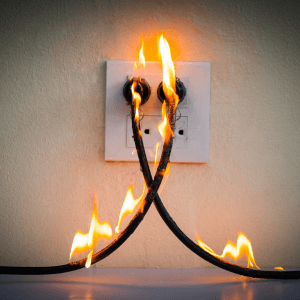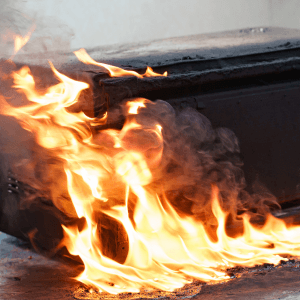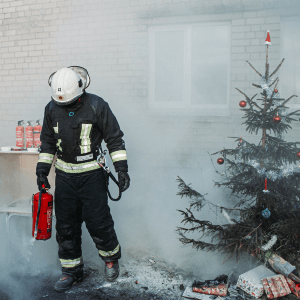In the blink of an eye, a small spark can turn into a full-blown fire hazard. With home fires being a leading cause of property damage, understanding how to put out fires can make all the difference. Fires can spread in mere seconds, and knowing how to respond swiftly is crucial for homeowners and restaurant owners alike. This blog post will guide you through the essential steps of putting out different types of fires, from grease and electrical to holiday-related hazards.
Fire safety isn’t just about having a fire extinguisher on hand—it’s about understanding the nuances of various fire types and using the right methods to extinguish them. Using the wrong approach can escalate a manageable situation into a full-blown emergency. Here, we’ll cover the common fire hazards you might encounter in your kitchen, living room, or restaurant, and provide actionable steps to handle them safely.
Grease Fires

What Causes a Grease Fire?
Grease fires are a common kitchen hazard. They typically start when cooking oil becomes too hot and begins to smoke. If the oil exceeds a certain temperature, it can catch fire. Unlike other fires, grease fires spread rapidly and are notoriously difficult to put out if you don’t know the proper techniques.
How to Put Out a Grease Fire
- Turn Off the Heat Source Immediately
The very first action should be to turn off the burner to stop feeding the flames with more heat. This helps prevent the fire from escalating.
- Do NOT Use Water
Water can cause the burning oil to splatter, potentially spreading the fire. It can also create steam explosions, making the fire much worse.
- Use a Metal Lid or Baking Sheet
Smother the flames by covering the pot or pan with a metal lid or baking sheet. This effectively cuts off the oxygen supply, which is essential for the fire to burn.
- Apply Baking Soda if Needed
Baking soda can also help extinguish small grease fires due to its ability to smother flames. Avoid using flour, as it is flammable and may exacerbate the situation.
- Use a Fire Extinguisher as a Last Resort
If the fire persists, use a Class B or K fire extinguisher. These are specifically designed to tackle grease fires in kitchens.
What NOT to Do
Never attempt to move the pan or pot if it’s on fire, as this could spread the flames. Additionally, do not try to fan the fire with a towel or cloth as it can give oxygen to the fire, causing it to grow.
Electrical Fires

What Causes an Electrical Fire?
Electrical fires are often caused by faulty wiring, overloaded outlets, or malfunctioning appliances. These types of fires can occur unexpectedly and spread quickly due to the availability of electrical sources.
How to Put Out an Electrical Fire
- Cut Off the Power Source
If safe to do so, unplug the device causing the fire or switch off the breaker. This action stops the flow of electricity, which is fueling the fire.
- Never Use Water
Using water on an electrical fire can lead to electrocution. It’s crucial to avoid using water as an extinguishing agent.
- Use a Class C Fire Extinguisher or Baking Soda
Opt for a Class C fire extinguisher, which is designed specifically for electrical fires. Alternatively, baking soda can be used to smother small fires.
- Evacuate and Call 911 if Necessary
If the fire is beyond control, prioritize safety. Evacuate immediately and call emergency services. The City of Austin has this helpful resource about emergency and non-emergency calls.
When to Call for Professional Help
After an electrical fire, it’s essential to have the damage assessed by a professional like Black Hill Restoration. We can evaluate the extent of the damage and ensure that no hidden risks remain in your electrical system.
Kitchen Fires

Overview of Common Kitchen Fire Hazards
Kitchen fires encompass more than just grease fires. Fires can erupt in stoves, ovens, and even microwaves. Understanding how to handle each scenario can prevent minor accidents from becoming major disasters.
How to Put Out a Kitchen Fire
Stove/Oven Fire
If a fire starts in the oven, turn it off immediately and keep the door closed to suffocate the flames. If needed, use a fire extinguisher to put out the fire.
Microwave Fire
Turn off and unplug the microwave. Keep the door closed to confine the fire. Use a fire extinguisher if the fire doesn’t subside.
Grease Fire
Refer back to the Grease Fire section for specific steps tailored to handling this common kitchen hazard.
Fire Extinguishers in the Kitchen
Having a Class ABC or Class K fire extinguisher within reach in your kitchen is a critical precautionary step. Ensure that all household members or restaurant staff know how to use them.
Holiday-Related Fire Hazards and How to Handle Them

Increased Fire Risks During the Holidays
The holiday season brings an uptick in fire hazards due to festive decorations, increased cooking, and the use of candles. These factors contribute to a higher risk of fires.
Christmas Tree Fires
A dry Christmas tree can ignite easily, especially if adorned with faulty lights. Keep your tree well-watered and away from heat sources, and use LED lights that stay cool to minimize risk. In case of a small fire, a fire extinguisher or water can be used if the fire is manageable. Always evacuate if the fire spreads.
Candle Fires
Candles create a warm atmosphere but can be dangerous if left unattended. Smother small candle fires with a metal lid or wet cloth. Ensure candles are far from flammable materials and never leave them burning unattended.
Cooking Fires During Holiday Feasts
With multiple dishes being prepared simultaneously, the likelihood of a kitchen mishap increases. Refer to the Grease Fire and Kitchen Fire sections for effective steps to tackle these fires.
String Lights and Electrical Decorations
Overloaded outlets and frayed wires from holiday lights can spark electrical fires. Refer to the Electrical Fire section for tips on handling these types of fires.
Learn more about year-round fire prevention here.
General Household Fires (Candles, Heaters, etc.)
What Causes Other Common Household Fires?
Common household items like candles, portable heaters, and fireplaces can also pose fire risks. Being aware of these risks is crucial for maintaining a safe environment.
How to Put Out Fires Around the Home
- Small Fire (Candle or Fabric)
Use water or a fire extinguisher to put out small fires involving candles or fabrics.
- Heater/Fireplace Fire
For portable heater or fireplace fires, turn off the appliance if safe and smother the flames with an extinguisher.
- If Uncertain
If you’re unsure about handling a fire, evacuate immediately and contact emergency services.
Dealing with a smoky smell post-fire? Read more here about how to remove the smoke odor.
Fire Extinguisher Types and When to Use Them

Different Types of Fire Extinguishers
Understanding fire extinguisher classifications is vital for effective fire response:
- Class A
For ordinary combustibles like wood and paper.
- Class B
Designed for flammable liquids like grease and gasoline.
- Class C
Specifically for electrical equipment fires.
Suitable for kitchen grease fires.
How to Use a Fire Extinguisher (PASS Method)
When using a fire extinguisher, follow these steps:
- Pull the pin.
- Aim the nozzle at the base of the fire.
- Squeeze the handle.
- Sweep the nozzle from side to side.
Even after the fire is extinguished, it’s important to secure your home from further damage or intrusion. Quick board-up services can help protect your property until repairs can begin. Learn more about why this step is crucial in our post: The Importance of Quick Board-Up Services After Disaster Strikes.
When to Evacuate
Knowing When a Fire Is Too Big to Handle
Safety is the top priority. If a fire is spreading or not contained, it’s time to evacuate and call emergency services.
Create a Fire Escape Plan
Prepare a fire escape plan for your home or business, detailing escape routes and regular fire drills. This preparation can save lives when every second counts.
Read more from our blog about what to do for fire damage restoration after the fire.
Stay Safe Year-Round: Fire Damage Restoration & Prevention You Can Trust
Fire safety is a crucial aspect of maintaining a safe home or business. By understanding the types of fires, from grease and electrical to holiday-related hazards, and how to extinguish them effectively, you can minimize the risk and ensure safety. During the holidays, when fire risks increase, vigilance is even more important.For those dealing with fire damage, Black Hill Restoration offers expert fire and smoke damage restoration, cleanup, and inspections. Our team is here to help you recover swiftly and safely. Contact us today for comprehensive fire damage solutions.

